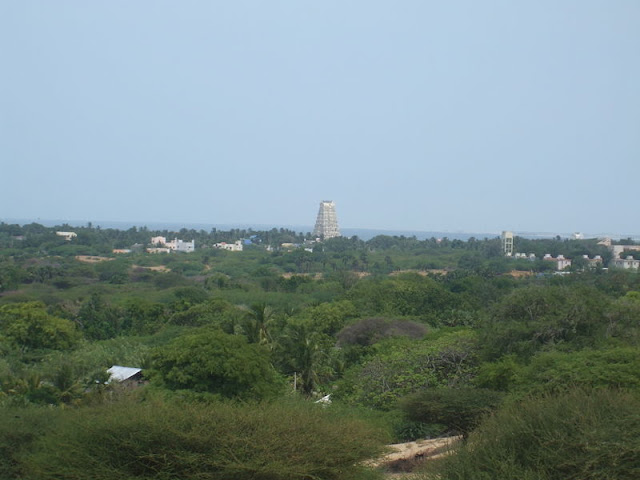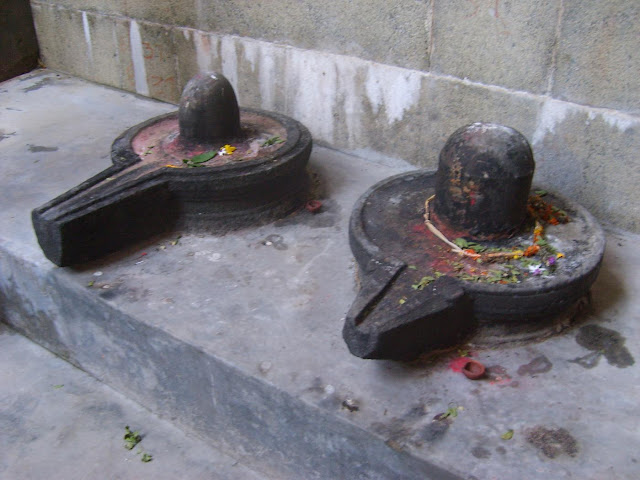Ramanathaswamy Temple, Rameswaram – The
Temple
Ramanathaswamy temple is the heart beat of every Hindu
and is built right in the center of the seaside town of Rameshwaram. The
magnificent temple is one of the 12 Jyothirlingas; the special temples of Siva
found in different parts of India and are considered on par with Benares. The
temple is special to the devotees of Lord Siva and Lord Vishnu. The temple is
spread over 15 acres, with lofty gopurams and massive walls. Rameswaram is one of the significant Dham in
all four Char Dham.
Like all ancient temples of South India, the high
compound wall (madil) on all four sides of the temple premises is about 865
feet long from east to west and 657 feet from north to south with huge towers
(Gopurams). The western Rajagopuram is impressive, but the eastern one is taller
and there are gate towers on the north and south as well. The 54 meter tall
Gopuram has nine levels.
The stucco image of Nandi is about 18 feet tall and 22
feet in length. It is believed that the ancient shrine was housed in a thatched
hut until the 12th century and that the 1st ever masonry structure was built by
Parakrama Bahu of Sri Lanka. The Sethupathy rulers of Ramanathapuram completed
the rest of the temple. Some of the temple vimanams resemble the Vimanams of
the Pallava period.
Much of the additions were carried out between the 12th
and the 16th centuries. The long corridor (3rd prakaram) dates back only to the
18th century. The Gandhamadhana Parvatam (hill) provides a good view of the
temple. This temple has received royal patronage from several kingdoms
such as Travancore, Ramanathapuram, Mysore and Pudukkottai. This is the 252nd
Devaram Paadal Petra Shiva Sthalam and 8th Sthalam of Pandya Nadu. Moovar
has sung hymns in praise of Lord Shiva of this temple.
The temple has long corridors inside between huge
colonnades on platforms above five feet high. The second corridor is formed by
sandstone pillars, beams and ceiling. The junction of the third corridor on the
west and the paved way leading from the western gopuram to Sethumadhava shrine is
designed as a chess board and called Chokkattan Mandapam. The Utsava
(processional) deities are decorated and kept in this mandapam (hall) during
the Vasantotsavam (spring festival), on the 6th day of the festival in Adi
(July–August) and Masi (February–March) conducted by the Sethupathi of Ramnad.
The outer set of corridors is reputed to be the longest
in the world at 6.9 m height and 400 feet long in the east and west and about
640 feet long in the north and south. The inner corridors are about 224 feet in
the east and west and about 352 feet in the north and south. The width varies
from 15.5 feet to 17 feet in the east and west and width varying between 14.5
feet to 17 feet in the north and south. The total length of these corridors
totals 3850 feet.
There are about 1212 pillars in the outer corridor with
a height of 30 feet from the floor to the center of the roof. Most of the 4,000
brilliantly carved pillars feature individual themes and are aligned in a
special way. The carved granite pillars are mounted on a raised platform and
its uniqueness lies in the fact that the rock is not indigenous to the island,
but was brought in from other parts of Tamilnadu across the sea.
Devotees enter the temple through the eastern gopuram.
They first offer prayers to Lord Anjaneya who is decorated with the orange
coloured sindhoor. A huge stucco figure of Nandi, the bull vehicle of Lord
Shiva, made of lime stone stands at about 6 m tall and 7 m in length in a
special Mandapa which also features the Dwajasthambam or flag staff. On either
side of the Nandi are the sculptures of the ocean gods Mahodadhi and Ratnakara.
The sanctum is flanked on either side by shrines of Vinayaka and Subrahmanya,
sons of Lord Shiva.
In the front mandapam, there is a carved canopy that
contains images of Rama, Sita, Lakshmana and Hanuman with the two Lingas
brought from Kailasam. Sugriva, the monkey king is shown informing Rama about
Hanuman’s return. In three other canopies in the front hall, we find
exquisitely-carved figures of Hanuman, Gandhamadhana Linga and Agastya Linga.
Parvadhavardhini is the consort of Lord Ramanatha and is
enshrined separately to the right of the main sanctum. There is a Sri Chakra
installed inside. The Devi shrine situated on the right of the Lord’s shrine,
similar to the Meenakshi’s in Madurai is very special. On Fridays, a decorated
icon of Parvadhavardhini is taken around the temple corridor in a golden
palanquin.
To the north of the Ramalinga shrine, Lord Vishwanatha
or Vishwalinga has a separate shrine. This is one of the two Lingas brought
from Kailash by Hanuman. As per tradition, pujas are first performed to
Vishwalinga and then to Ramalinga. In the first inner corridor, Visalakshi,
consort of Vishwanatha, is enshrined. Sayanangriha (Palliyarai or bedroom) is in
the north-eastern corner of the corridor around the Visalakshi shrine.
The gold figure of Lord Shiva is ceremoniously brought
here every night from the main shrine and placed in the Oonjal (swing) by the
side of the Devi’s golden icon. The Sayana puja and the early morning puja,
when the Lord is taken back in a procession to the sanctum, are highlights of
the daily rituals in the temple.
The special Jyothirlinga is in the first inner corridor
where devotees offer worship to the Spatika Linga installed by Vibhishana,
Ravana’s successor as King of Lanka. This Linga is the southernmost among the
12 famous Jyothirlingas in the country.
The 36 Theerthams or the Water springs are very special
and a bath in each one is part of the rituals. The water from each well is
supposed to taste different and is endowed with curative features. Guides lead
you through all the wells in a chronological order. 22 wells are inside the
temple. The waters possess medicinal properties and bathing in these is
considered to be of great significance.
The primary deity of the temple is Ramanathaswamy (Shiva) in the form of lingam. There are two lingams inside the sanctum - one
built by Goddess Sita, from sand, residing as the main deity, Ramalingam and
the one brought by Lord Hanuman from Kailash called Vishwalingam. Rama instructed that
Vishwalingam should be worshipped first since it was brought by Lord Hanuman -
the tradition continues even today.
Inside the sanctum is Sri Ramanathaswamy and this Lingam
is supposed to have the marks of Hanuman’s tail as he had tried to uproot it in
a fit of anger. The Linga is covered with silver kavacham/covering.
Mandapams:
There are various halls
(Mandapams) inside the temple, namely Anuppu Mandapam, Sukravara Mandapam,
Sethupathi Mandapam, Kalyana Mandapam and Nandi Mandapam.
For brief details, please refer below link;
Gopurams (Towers):
The skyscraping gopurams (spires) truly dominate the
skyline of Rameshwaram. The east tower is 126 feet in height and the west
tower is 78 feet in height. There are unfinished gopurams on the north and
south side entrances which was completed recently.
For brief details, please refer below link;
Temple Corridors (Prakarams):
Like all ancient temples in South
India, there is a high compound
wall (madil) on all four sides of the temple premises measuring about 865 feet
furlong from east to west and one furlongs of 657 feet from north to south with
huge towers (Gopurams) at the east and west and finished gate towers on the
north and south. The temple has striking long corridors in its interior, running
between huge colonnades on platforms above five feet high.
The second corridor is formed by sandstone pillars,
beams and ceiling. The junction of the third corridor on the west and the paved
way leading from the western gopuram to Setumadhava shrine forms a unique
structure in the form of a chess board and it is popularly known as Chokkattan Mandapam
where the Utsava deities are adorned and kept during the Vasantotsavam (Spring festival)
and on the 6th day festival in Adi (July–August) and Masi (February–March)
conducted by the Sethupathi of Ramnad.
The outer set of corridors is reputed to be the longest
in the world being about 6.9 m height, 400 feet in each in the east and west
and about 640 feet in north and south and inner corridors are about 224 feet in
east and west and about 352 feet each in north and south. Their width varies
from 15.5 feet to 17 feet in the east and west about 172 feet on the north and
south with width varying 14.5 feet to 17 feet.
The total length of those corridors is thus 3850 feet.
There are about 1212 pillars in the outer corridor. Their height is about 30
feet from the floor to the center of the roof. The main tower or Rajagopuram is
53 m tall. Most pillars are carved with individual composition.
For brief details, please
refer below link;
Shrines:
There are separate shrines
for God Ramanathaswamy and Goddess Parvadhavardhini separated by a
corridor. There are separate shrines for goddess Visalakshi,
Parvadhavardhini, Utsava idol, Sayanangriha, perumal, and Mahaganpathy.
For brief details, please
refer below link;
























































































































